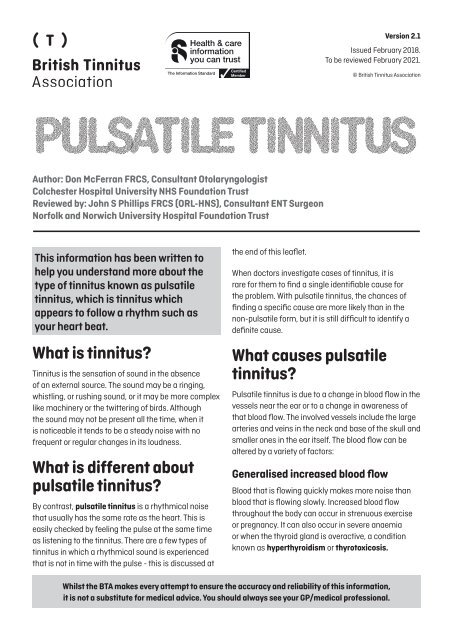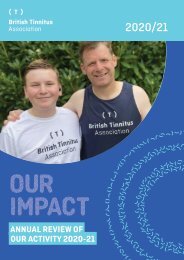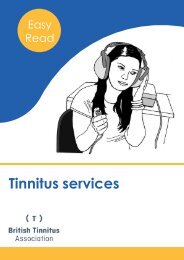You also want an ePaper? Increase the reach of your titles
YUMPU automatically turns print PDFs into web optimized ePapers that Google loves.
<strong>Ver</strong>sion <strong>2.1</strong><br />
Issued February 2018.<br />
To be reviewed February 2021.<br />
© British <strong>Tinnitus</strong> Association<br />
PULSATILE TINNITUS<br />
Author: Don McFerran FRCS, Consultant Otolaryngologist<br />
Colchester Hospital University NHS Foundation Trust<br />
Reviewed by: John S Phillips FRCS (ORL-HNS), Consultant ENT Surgeon<br />
Norfolk and Norwich University Hospital Foundation Trust<br />
This information has been written to<br />
help you understand more about the<br />
type of tinnitus known as pulsatile<br />
tinnitus, which is tinnitus which<br />
appears to follow a rhythm such as<br />
your heart beat.<br />
What is tinnitus?<br />
<strong>Tinnitus</strong> is the sensation of sound in the absence<br />
of an external source. The sound may be a ringing,<br />
whistling, or rushing sound, or it may be more complex<br />
like machinery or the twittering of birds. Although<br />
the sound may not be present all the time, when it<br />
is noticeable it tends to be a steady noise with no<br />
frequent or regular changes in its loudness.<br />
What is different about<br />
pulsatile tinnitus?<br />
By contrast, pulsatile tinnitus is a rhythmical noise<br />
that usually has the same rate as the heart. This is<br />
easily checked by feeling the pulse at the same time<br />
as listening to the tinnitus. There are a few types of<br />
tinnitus in which a rhythmical sound is experienced<br />
that is not in time with the pulse - this is discussed at<br />
the end of this leaflet.<br />
When doctors investigate cases of tinnitus, it is<br />
rare for them to find a single identifiable cause for<br />
the problem. With pulsatile tinnitus, the chances of<br />
finding a specific cause are more likely than in the<br />
non-pulsatile form, but it is still difficult to identify a<br />
definite cause.<br />
What causes pulsatile<br />
tinnitus?<br />
<strong>Pulsatile</strong> tinnitus is due to a change in blood flow in the<br />
vessels near the ear or to a change in awareness of<br />
that blood flow. The involved vessels include the large<br />
arteries and veins in the neck and base of the skull and<br />
smaller ones in the ear itself. The blood flow can be<br />
altered by a variety of factors:<br />
Generalised increased blood flow<br />
Blood that is flowing quickly makes more noise than<br />
blood that is flowing slowly. Increased blood flow<br />
throughout the body can occur in strenuous exercise<br />
or pregnancy. It can also occur in severe anaemia<br />
or when the thyroid gland is overactive, a condition<br />
known as hyperthyroidism or thyrotoxicosis.<br />
Whilst the BTA makes every attempt to ensure the accuracy and reliability of this information,<br />
it is not a substitute for medical advice. You should always see your GP/medical professional.
Localised increased flow<br />
Sometimes blood flow is increased in a single<br />
blood vessel or group of blood vessels rather than<br />
a generalised increase. For example, during foetal<br />
development we all have an artery in our middle ear<br />
called the stapedial artery. This normally closes<br />
before birth but it can occasionally persist and in this<br />
case blood flow adjacent to middle ear structures<br />
can generate pulsatile tinnitus. Tumours of the head<br />
and neck cause the development of abnormal blood<br />
vessels and this can result in pulsatile tinnitus. The<br />
majority of tumours associated with pulsatile tinnitus<br />
are benign rather than malignant.<br />
Turbulent blood flow<br />
If the inside of a blood vessel becomes irregular due<br />
to atherosclerosis (hardening of the arteries), the<br />
blood flow will become turbulent rather than smooth.<br />
This flow then becomes noisy in the same way that a<br />
smoothly running river will become noisier at a set of<br />
rapids or waterfall.<br />
Altered awareness<br />
Awareness can be increased by several factors:<br />
• Conductive hearing loss such as a perforated ear<br />
drum or glue ear tend to make people more aware of<br />
sounds inside their body because they no longer<br />
have the masking effect of external sounds.<br />
• Heightened sensitivity in the auditory pathways<br />
can alert the brain to normal noise in blood<br />
vessels in much the same way that the awareness<br />
of non-pulsatile tinnitus is generated.<br />
Miscellaneous<br />
Some causes of pulsatile tinnitus do not fall into any of<br />
the above categories. In particular, there is a condition<br />
called benign or idiopathic intracranial hypertension,<br />
which is characterised by headaches and visual<br />
disturbance as well as pulsatile tinnitus. This is said to<br />
occur most frequently in overweight young or middle<br />
aged women. However, it can occur at any age and in<br />
men as well as women. Its cause remains unknown.<br />
It is important to state that this is not an exhaustive<br />
list of the causes of pulsatile tinnitus and that anyone<br />
with this symptom should seek assessment by an<br />
appropriate doctor.<br />
How is pulsatile tinnitus<br />
investigated?<br />
The doctor will start by taking a detailed history of<br />
the tinnitus and will ask about any other medical<br />
conditions that you may have. The doctor will then<br />
examine you, paying particular attention to the ear<br />
drums and the blood vessels of the neck.<br />
A stethoscope may be used to listen to the neck and<br />
skull–if the doctor can hear a pulsatile noise through<br />
the stethoscope this is referred to as objective<br />
pulsatile tinnitus. <strong>Pulsatile</strong> tinnitus that cannot be<br />
heard by the doctor is called subjective pulsatile<br />
tinnitus. People with any form of tinnitus will have<br />
a series of hearing tests and pulsatile tinnitus is no<br />
different in this respect.<br />
People with pulsatile tinnitus will generally then<br />
undergo some form of medical imaging. This has<br />
changed dramatically in recent years and a wider<br />
range of techniques are now available:<br />
Ultrasound<br />
This is a similar test to the scan performed on a<br />
pregnant woman. Modern ultrasound scanning uses<br />
a technique called Doppler, which can show the blood<br />
flow within the blood vessels in the neck.<br />
Magnetic resonance imaging (MRI)<br />
This produces pictures of the head and inner ears<br />
using magnetic fields rather than X-rays. Some<br />
conditions are better shown with MRI; some are better<br />
shown with CT. Therefore the tests are complementary<br />
and some people may need both CT and MRI scans.<br />
Magnetic resonance angiography (MRA)<br />
MRA can be used to produce images of the inside<br />
of arteries or veins and can show up irregularities or<br />
narrowing of the vessel.<br />
Whilst the BTA makes every attempt to ensure the accuracy and reliability of this information,<br />
it is not a substitute for medical advice. You should always see your GP/medical professional.
Computerised tomography (CT)<br />
This technique uses computer controlled X-rays to<br />
generate detailed images of the body.<br />
Computerised tomographic<br />
angiography (CTA)<br />
By giving an injection of a substance that shows up<br />
on X-rays (contrast medium) and then performing a<br />
CT scan it is possible to obtain images of the inside of<br />
blood vessels.<br />
Angiography<br />
This is a way of looking at the inside of vessels by<br />
injecting contrast medium into the vessel under<br />
investigation and taking a conventional X-ray. It still<br />
produces clearer, more detailed pictures of vessels<br />
than any of the other techniques and therefore is still<br />
used in selected cases.<br />
Other investigations<br />
Blood tests may be needed in the investigation of<br />
pulsatile tinnitus. For example, a full blood count<br />
(FBC) may be required to rule out anaemia or thyroid<br />
function tests (TFTs) may be requested if an overactive<br />
thyroid gland is suspected. If benign intracranial<br />
hypertension is suspected, the doctor may ask for<br />
opinions from other doctors such as ophthalmologists<br />
or neurologists who may request their own specialised<br />
investigations.<br />
What can be done about<br />
pulsatile tinnitus?<br />
If a specific cause is found, this may point to a specific<br />
solution. For example, anaemia can be treated with<br />
medication or blood transfusion, glue ear can be<br />
treated with grommets, perforations can be closed<br />
with grafts and narrowed segments of artery can be<br />
repaired.<br />
Some causes are less amenable to treatment: if the<br />
pulsatile tinnitus is due to a specific blood vessel,<br />
these may not be treatable, depending on location.<br />
For those people with pulsatile tinnitus who have<br />
no demonstrable abnormality, there are a variety of<br />
methods to manage the tinnitus which people find<br />
helpful. These include techniques such as sound<br />
therapy, relaxation therapy, Cognitive Behavioural<br />
Therapy (CBT), counselling, mindfulness meditation, or<br />
<strong>Tinnitus</strong> Retraining Therapy (TRT).<br />
Other forms of rhythmical<br />
tinnitus<br />
There are a few examples of tinnitus where a<br />
rhythmical sound is experienced but the sound is<br />
not synchronised with the person’s heart beat. This<br />
type of tinnitus is most commonly due to rhythmical<br />
contraction of the muscles in the middle ear.<br />
There are two small muscles in the middle ear called,<br />
the tensor tympani and stapedius. Occasionally these<br />
muscles can go into rhythmical contraction – in much<br />
the same way that the muscles at the corner of the<br />
eye can twitch when we get tired. This process is called<br />
myoclonus.<br />
More rarely, this type of rhythmical tinnitus can be<br />
caused by contraction of some of the muscles of the<br />
soft palate at the back of the throat. People with these<br />
forms of tinnitus should consult their doctor as there<br />
is a small chance that an underlying cause can be<br />
detected. However, in the vast majority of cases there<br />
is no reason for the symptom.<br />
Many people with this type of tinnitus are able to<br />
tolerate it easily once they understand that there is no<br />
serious cause. If not, it is possible to perform a surgical<br />
procedure to cut the muscles in the middle ear or to<br />
inject botulinum toxin into the palatal muscles.<br />
There is another rare type of tinnitus called Patulous<br />
Eustachian Tube Syndrome in which people<br />
experience a form of tinnitus that varies with their<br />
breathing. They may also feel that their ear seems<br />
blocked and their voice seems to echo inside their<br />
head. This condition is actually due to excessive<br />
openness of the Eustachian tube – the tube that runs<br />
from the back of the nose to the inside of the ear.<br />
Whilst the BTA makes every attempt to ensure the accuracy and reliability of this information,<br />
it is not a substitute for medical advice. You should always see your GP/medical professional.
This tube is normally shut and only opens for a very<br />
short time when we yawn or swallow. If it becomes<br />
abnormally open the pressure changes caused by<br />
our breathing is transmitted via the tube to the inside<br />
of the ear. Many people with this condition report<br />
that it started after a period of sudden weight loss.<br />
People who think they might have this condition<br />
should consult their doctor. Various treatments have<br />
been tried including injecting material around the<br />
tube or cauterising the opening of the tube to reduce<br />
its patency (degree of openness). Again, there are<br />
a number of techniques which can be helpful in<br />
managing this tinnitus sound therapy, relaxation<br />
therapy, CBT, counselling, mindfulness meditation, or<br />
TRT.<br />
References<br />
A list of the references used in preparing and reviewing<br />
this leaflet is available on request.<br />
Alternative formats<br />
This publication is available in large print on request.<br />
For further information<br />
Our helpline staff can answer your questions on<br />
any tinnitus related topics on 0800 018 0527. You<br />
may also find our website takeontinnitus.co.uk<br />
helpful.<br />
BTA publications<br />
Our information leaflets are written by leading tinnitus<br />
professionals and provide accurate, reliable and<br />
authoritative information which is updated regularly.<br />
Please contact us if you would like to receive a copy of<br />
any of our information leaflets listed below, or they can<br />
be downloaded from our website. *available in Easy<br />
Read<br />
All about tinnitus*<br />
Balance and tinnitus<br />
Complementary therapy for tinnitus: an opinion<br />
Drugs and tinnitus<br />
Ear wax removal and tinnitus<br />
Flying and the ear<br />
Food, drink and tinnitus<br />
Hearing aids and tinnitus*<br />
Hyperacusis<br />
Ideas for relaxation without sound<br />
Information for musicians<br />
Musical hallucination (musical tinnitus)<br />
Noise and the ear<br />
Otosclerosis<br />
<strong>Pulsatile</strong> tinnitus<br />
Relaxation<br />
Self help for tinnitus*<br />
Sound therapy<br />
Sources of mutual support for tinnitus<br />
Supporting someone with tinnitus<br />
Taming tinnitus<br />
<strong>Tinnitus</strong>: a parent’s guide<br />
<strong>Tinnitus</strong>: a teacher’s guide<br />
<strong>Tinnitus</strong> and disorders of the temporomandibular<br />
joint (TMJ) and neck<br />
<strong>Tinnitus</strong> and sleep disturbance<br />
<strong>Tinnitus</strong> and stress<br />
<strong>Tinnitus</strong> services*<br />
Leaflets for children:<br />
Ellie, Leila and Jack have tinnitus (for under 8s)<br />
<strong>Tinnitus</strong> (for 8-11 year olds)<br />
<strong>Tinnitus</strong> (for 11-16 year olds)<br />
Ellie, Leila and Jack and me have tinnitus activity book (for<br />
under 8s)<br />
<strong>Tinnitus</strong> activity book (for 8-11 year olds)<br />
<strong>Tinnitus</strong> activity book (for 11-16 year olds)<br />
British <strong>Tinnitus</strong> Association<br />
Ground Floor, Unit 5, Acorn Business Park, Woodseats Close, Sheffield S8 0TB<br />
Email: info@tinnitus.org.uk<br />
Helpline: 0800 018 0527<br />
Website: tinnitus.org.uk<br />
The British <strong>Tinnitus</strong> Association. Registered charity no: 1011145 Company limited by guarantee no: 2709302. Registered in England. This information has<br />
been produced by the BTA and conforms to the Principles and Requirements of the Information Standard.<br />
Whilst the BTA makes every attempt to ensure the accuracy and reliability of this information,<br />
it is not a substitute for medical advice. You should always see your GP/medical professional.


















